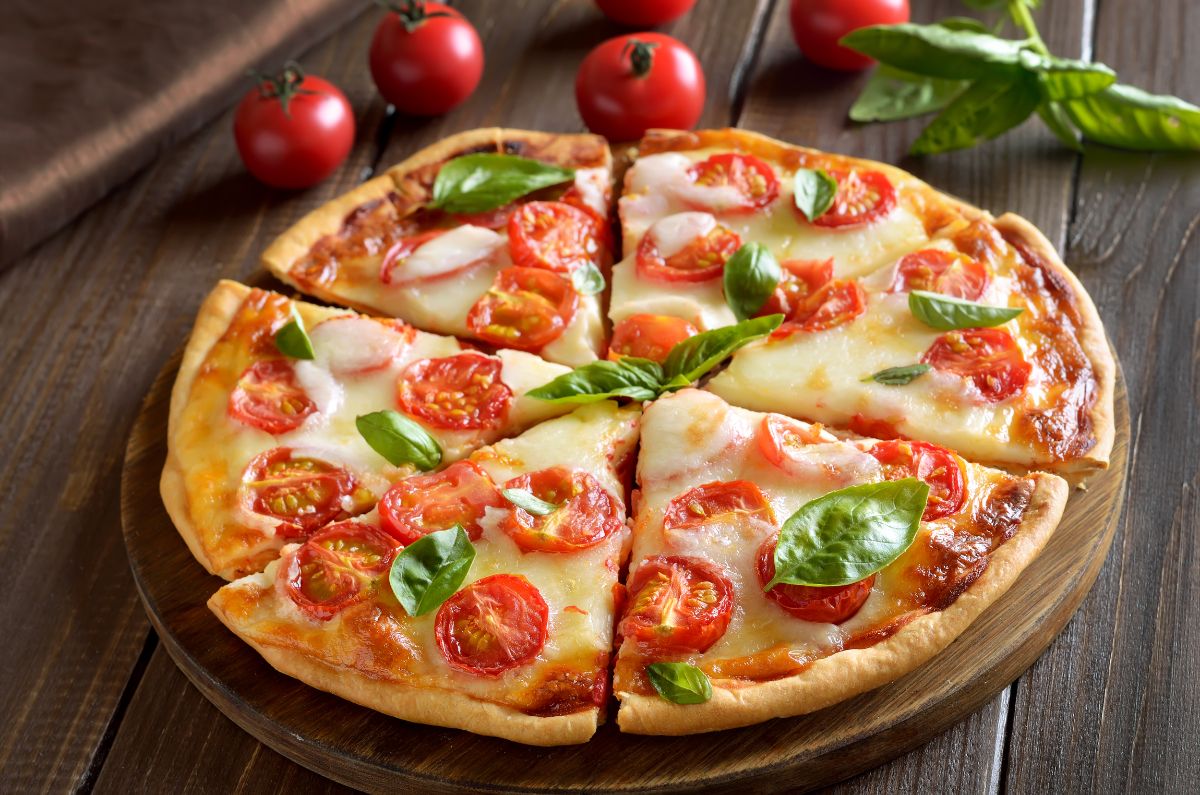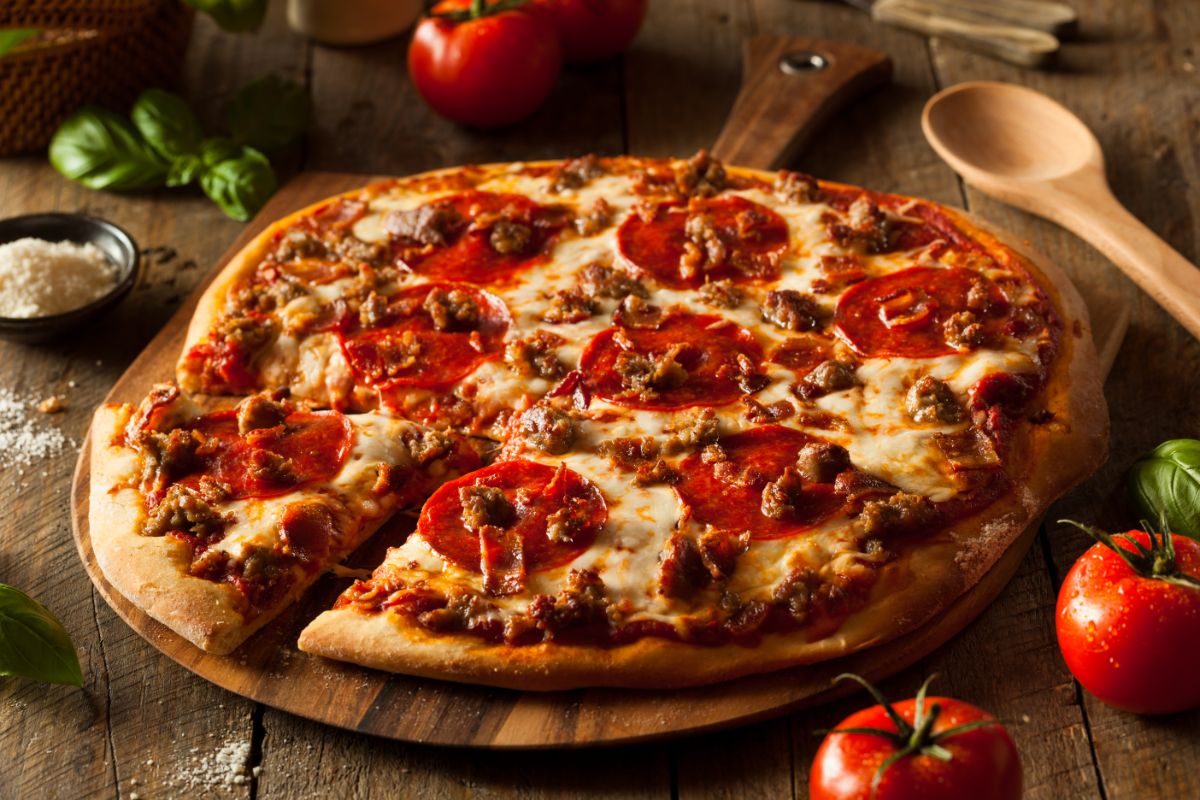It is possible to have rich melted cheese or even burned cheese on your pizza and still have undercooked pizza dough. You can also end up with pizza dough that is unevenly cooked or failed to bake all the way through. In every case, the pizza could be dangerous to eat. Let’s answer some of the most common questions people have about cooking pizza dough.

So, how can you tell if pizza dough is undercooked? The simple answer is to check the bottom of the pizza. If the dough is still raw, it isn’t getting hot enough to fully cook it or needs more time to fully cook.
Something to look out for is a pizza recipe that makes the pizza dough soggy. For example, pineapple on the pizza will moisten the crust, though it may be fully cooked when done.
If you add too much sauce, the pizza may seem to be undercooked, too, though it is perfectly edible.
Putting too many toppings on thin crust pizza can create an unevenly cooked pizza or burnt crust by the time the dough is fully cooked.
On thin pizzas with very thick toppings, you could also get undercooked toppings on a fully cooked crust, especially if the pizza is sitting right on top of a working bottom heating element or the fire.
One solution is to limit yourself to just two or three toppings on top of the cheese. If you want more ingredients than this, switch to a thicker crust pizza in a pizza pan knowing it will cook longer at a lower temperature.
A side benefit of this is knowing the crust won’t give way when you pick up the heavier load.
*This article may contain affiliate links. As an Amazon Associate, I earn from qualifying purchases. Please take that into account.
- Dutch oven
- Large mixing bowl
- Measuring cups and spoons
- Bread thermometer (fancy or a budget one)
- Scoring lame
Extra (nice to have):
- Kitchen scale
- Dough scraper and bowl scraper (yes, they are different)
- Cooling rack
- Baking stone (you don’t need a dutch oven if you use this)
👉Learn how to make bread and pizza with this awesome book.
How Can You Recover Undercooked Pizza Dough?
Do not try to make up for the undercooked pizza dough by turning on the convection oven the next time you make pizza. You’ll end up burning it. Instead, turn the heat down or put the pizza on a lower rack so you can cook it without burning the upper layers.
If you made slow cooker pizza, you can try to salvage it by removing the ingredients, pricking the dough to create an outer rim, and then par-bake it for eight to ten minutes.
Take out the dough, add the ingredients, and return it to the oven for several more minutes. This will ensure that the dough is fully cooked without drying out or burning the ingredients.
How Long Should You Cook Pizza Dough in the Oven?

If you’re cooking a thin crust pizza, you can cook it in the oven for 10 to 15 minutes at 425 degrees. Thicker pizza should be baked at 400 to 425 degrees for 15 minutes to 20 minutes.
Note that thicker dough and ingredients will add to the cooking time.
How Long Should You Cook Pizza Dough in a Slow Cooker?
Slow cooker pizza is by definition thick. It can also be delicious since the juices have time to marinade. It is convenient since you can have it almost any time.
But how much time do you need? The slow cooker should be run for one and a half to two hours on a low setting. You can make sure the dough is fully cooked by waiting until the edges of the crust are golden brown and all of the cheese is melted.
Why Does Pizza Dough End Up Undercooked?
One common reason for this is that someone didn’t preheat the oven long enough. In general, the oven needs to be preheated for half an hour to 500 degrees F, and this includes the pizza pan in most cases.
The problem is worsened by the use of pizza stones. The pizza takes five to six minutes to cook for thin crust pizza and eight to ten minutes for thick crust pizza, assuming the pizza stone is 500-500 degrees.
You also want to preheat pans, if you can, since the dough is only done when the bottom is fully baked. With a steel pan, you’ll generally need the oven at 475 degrees F for 12 to 15 minutes. If you’re using a thinner metal pan, then you can lower the temperature to 425 degrees.
You’ll certainly get undercooked pizza dough if you use the temperature and time settings for thin-crust pizza on a thick crust pizza.
Another variation of this mistake is not adding time to the timer to make up for your heavy topping load. You might be able to avoid the undercooked dough next time by baking the meat, cheese, sauce, and bread but adding any peppers, onions and other ingredients after the pizza is out of the oven.
Another tactic is drying out the toppings. You absolutely have to drain canned pineapple and ground meat before you add it to the pizza. Soggy toppings will make the crust soggy.
You double the risk of getting sick if you don’t fully cook meat before putting it on pizza that doesn’t fully cook. Always precook sausage, steak, chicken, and bacon before adding them.
You can also get undercooked pizza because the oven settings were based on the assumption the pizza was right under the broiler.
For example, the cooking time we mentioned for pizza stones is based on the pizza stone being about ten inches below the broiler. Set it on the bottom of the oven, and you risk undercooked pizza dough.
If the top of the pizza is burned but the bottom is undercooked, put it on a lower rack in the oven and give it an extra two or three minutes to bake next time.
Why Might My Pizza Seem Undercooked?
If you’re using oil on the bottom of a slow cooker or baking sheet to make the pizza easier to remove, this could make the pizza’s crust seem doughy though it is fully cooked.
Next time, try to cook the pizza on a layer of parchment paper. If you’re constantly getting gooey pizza, consider switching from liquid sauces to concentrated tomato paste with any additional spaces.
Spread that over the dough and then add your ingredients. Since there is less moisture than tomato sauce, you’re less likely to end up with a dough that seems undercooked.
